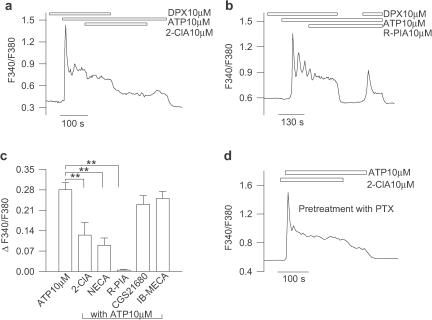Figure 5.
The A1 receptor mediates the adenosine-induced depression of the sustained [Ca2+]i response. (a) In the presence of the selective A1 receptor antagonist DPX (10 μM), 2-ClA (10 μM) did not cause a reduction of the ATP-evoked [Ca2+]i plateau; after DPX removal, 2-ClA caused a sustained decrease of the steady-state [Ca2+]i signal, which recovered upon 2-ClA washout. (b) In another representative astrocyte, the washing of DPX applied in conjunction with 10 μM R-PIA promoted a complete and reversible depression of the ATP-evoked sustained [Ca2+]i rise. (c) Among the several P1 agonists tested with the same procedure of panel a, the broad-spectrum agonists NECA and 2-ClA as well as the A1 selective agonist R-PIA caused a significant depression of the sustained [Ca2+]i responses, which instead were unchanged in the presence of the selective A2A agonist CGS-21680 or the selective A3 agonist IB-MECA. Mean±s.e.m. of at least 15 astrocytes for each condition. **, P<0.01 vs ATP 10 μM alone. (d) Coapplication of 10 μM ATP and 10 μM 2-ClA on a representative astrocyte from cultures, which have been preincubated for 24 h with PTX (200 ng ml−1), evoked a [Ca2+]i signal that was kinetically similar to that induced by ATP alone.

